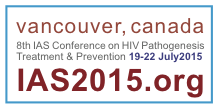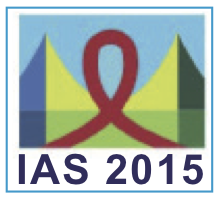News and notes on HIV cure research from IAS 2015
1 October 2015. Related: Conference reports, Cure-related research, IAS 8th Vancouver 2015.
The IAS 2015 conference and related satellite meetings in Vancouver produced a slew of research news. Below are links to some presentations of possible interest and information on how to find materials online.
2015 Towards an HIV Cure symposium
 On July 18 & 19, immediately preceding the main conference, the fifth IAS Towards an HIV Cure Symposium took place. Most of the presentations (divided into day 1 and day 2) and posters are now posted, along with the abstract book, with audio pending. [1]
On July 18 & 19, immediately preceding the main conference, the fifth IAS Towards an HIV Cure Symposium took place. Most of the presentations (divided into day 1 and day 2) and posters are now posted, along with the abstract book, with audio pending. [1]
Among the most talked about presentations (beyond Asier Sáez-Cirión’s widely publicised description of long-term virological remission in a teenager, covered on the blog previously) [2] was Jonathan Karn’s report that estrogen receptors appear to play a role in HIV latency in CD4 T cells. Karn also presented his results at IAS 2015 and a webcast of the talk is available. [3]
Karn showed results from laboratory studies indicating sex differences in responses to latency-reversing agents; specifically, reversal of HIV latency by a variety of different compounds was profoundly inhibited by the hormone estradiol in women but not men. Conversely, compounds that antagonise the estrogen receptor—such as the breast cancer treatments tamoxifen and fulvestrant—enhanced latency reversal. Karn’s research is part of an ongoing amfAR-funded effort to better understand HIV latency and reservoirs in women. [4]
During the Q&A after Karn spoke, Brigitte Autran mentioned a French study (by Lise Cuzin and colleagues) of men and women on long-term ART that found that HIV DNA levels were significantly lower in women; these results have just been published in the journal AIDS. [5]
John Mascola from the Vaccine Research Center at the National Institutes of Health offered a glimpse at the viral load reductions obtained in a phase I trial of the broadly neutralising antibody (bNAb) VRC01 in HIV positive individuals not yet on ART. [6] After a single VRC01 dose viral load fell by around 1-1.5 logs, with six out of eight participants experiencing a 10-fold or greater drop. The two individuals who did not see a viral load decline turned out to have VRC01-resistant virus at baseline, suggesting that bNAbs will need to be combined to maximise their effects. These data are due to be published soon and are not included in the version of Mascola’s presentation that has been posted online.
The results looked generally compatible with those obtained with the bNAb 3BNC117. [7]
Andrés Finzi discussed the possibility of exploiting the antibodies that are already present in HIV positive people as a means to eliminate virus-infected cells. Finzi’s group has identified compounds known as CD4 mimetics that can alter the state of the HIV envelope in a way that allows common non-neutralising antibodies to induce antibody-mediated cellular cytotoxicity (ADCC) and thereby mediate killing of HIV-infected CD4 T cells.
Unfortunately Finzi’s powerpoint presentation [8] seems to have been mangled by the translation into PDF form but the work was published recently in PNAS. [9]
Finzi believes the CD4 mimetics will be amenable to testing as oral drugs, and might provide an alternative to injectable bNAbs for the purposes of inducing ADCC against HIV-infected cells after latency reversal.
Christopher Peterson won the IAS young investigator award for his work demonstrating that stem cells genetically modified to abrogate expression of the CCR5 receptor can be successfully transplanted in the pigtailed macaque model. Peterson showed that the approach gave rise to gene-modified immune cells of multiple lineages, both in normal pigtailed macaques and SHIV-infected animals on ART. Results of studies evaluating the anti-SHIV effects of the transplants will be available soon. [10]
IAS 2015
The main conference website does not have the most user-friendly system for accessing presentations and abstracts. The portal is called the programme-at-a-glance, but you may find yourself doing more squinty-eyed poring and clicking than glancing. There is a helpful section called roadmaps that lists conference sessions by topic area, such as “HIV Pathogenesis,” “Towards an HIV Cure” and “Vaccine.” Slides and webcasts (where available) are accessed via the conference session where the presentation occurred. [11]
The abstracts page allows browsing of different categories and the filtering option can be used to limit browsing to just posters. As far as I can tell, there is no way of searching abstracts using keywords. An IAS 2015 abstract book has been published by the Journal of the International AIDS Society (both in PDF and HTML format), but it only includes the few posters presented in oral discussion sessions. [12]
Additional cure research presentations at IAS 2015 included an excellent overview of the field by Nicolas Chomont, available as a webcast. [13]
Jake Estes described a potentially important new technology capable of visually identifying SIV-infected cells in macaque tissues. Both viral RNA and DNA can be visualised, which has the potential to shed light on the locations of the latent virus reservoir in ART-treated animals. The technology is called RNAscope and DNAscope in situ hybridisation. Estes’s slides can be downloaded (but due to the many images it is a huge 64MB file). [14]
Susana Valente discussed how Tat inhibition may lockdown latent HIV, impeding its ability to reactivate – the opposite strategy to latency reversal (Valente describes it as “silencing the HIV reservoir”). The work was published recently in the open access journal mBio [15] and Valente’s talk is webcast. [16]
On the HIV vaccine front, two excellent overview presentations are available via webcast: Tony Fauci discussed the state of the field in a talk titled “Progress and challenges in HIV prevention,” while Glenda Gray delivered a plenary talk that focused on plans for the next round of efficacy trials. [17, 18]
Source:
TAG basic science blog. News and Notes on HIV cure research from IAS 2015 (31 Jul 2015).
http://tagbasicscienceproject.typepad.com/tags_basic_science_vaccin/2015/07/news-and-notes-from-ias-2015.html
References:
- IAS Towards an HIV Cure Symposium. 18-19 July 2015, Vancouver.
http://www.iasociety.org/What-we-do/Towards-an-HIV-Cure/Events/2015-Symposium - Jefferys R. New case of “remission” reported in a perinatally infected teenager. TAG basic science blog. (23 July 2015).
http://tagbasicscienceproject.typepad.com/tags_basic_science_vaccin/2015/07/new-case-of-remission-reported-in-a-perinatally-infected-teenager.html - Karn J. Estrogen blocks HIV re-emergence from latency and points to gender-specific differences in HIV reservoirs. Oral presentation. IAS Towards an HIV Cure Symposium. 18-19 July 2015, Vancouver.
http://www.iasociety.org/Web/WebContent/File/HIV_Cure_Symposium_2015/Day1/Presentations/OA1-4 LB_Karn.pdf (PDF)
IAS 2015 webcast:
http://pag.ias2015.org/PAGMaterial/Webcast/2223_13076/webcast.mp4 - amfAR press release. Pursuit of HIV Cure Gets Funding Boost from amfAR. (15 January 2014).
http://www.amfar.org/hiv-boost - Cuzin L et al. Levels of intracellular HIV-DNA in patients with suppressive antiretroviral therapy. Concise communication. AIDS 29(13);1665–1671. (24 August 2015). doi: 10.1097/QAD.0000000000000723.
http://journals.lww.com/aidsonline/Abstract/2015/08240/Levels_of_intracellular_HIV_DNA_in_patients_with.11.aspx - Mascola JR. Neutralising antibodies: potential role in HIV-1 treatment approaches. Oral presentation. IAS Towards an HIV Cure Symposium. 18-19 July 2015, Vancouver.
http://www.iasociety.org/Web/WebContent/File/HIV_Cure_Symposium_2015/Day1/Presentations/IS-1_Mascola.pdf (PDF) - Jeffery R. Broadly neutralising antibody suppresses HIV in clinical trial. TAG basic science blog. (09 April 2015).
http://tagbasicscienceproject.typepad.com/tags_basic_science_vaccin/2015/04/broadly-neutralising-antibody-suppresses-hiv-in-clinical-trial.html - Finzi C et al. CD4 mimetics sensitise HIV-1-infected cells to ADCC. Oral presentation. IAS Towards an HIV Cure Symposium. 18-19 July 2015, Vancouver.
http://www.iasociety.org/Web/WebContent/File/HIV_Cure_Symposium_2015/Day1/Presentations/OA2-6_Finzi.pdf (PDF) - Richard J et al. CD4 mimetics sensitise HIV-1-infected cells to ADCC. PNAS 112(20);E2687–E2694, doi: 10.1073/pnas.1506755112. (19 May 2015).
http://www.pnas.org/content/112/20/E2687.abstract - Peterson C et al. Zinc finger nuclease gene editing for functional cure in a nonhuman primate model of HIV/AIDS. Oral presentation. IAS Towards an HIV Cure Symposium. 18-19 July 201n, Vancouver.
http://www.iasociety.org/Web/WebContent/File/HIV_Cure_Symposium_2015/Day2/Presentations/OA4-3_Peterson.pdf (PDF) - IAS 2015 online programme at a glance.
http://pag.ias2015.org - IAS 2015 abstract book.
http://www.jiasociety.org/index.php/jias/issue/view/1475 - Chomont N. From care to a cure. IAS 2015. IAS 2015, MOPL0103.Webcast.
http://pag.ias2015.org/PAGMaterial/Webcast/66_13222/webcast.mp4 - Estes J. In-vivo visualization of the latent reservoir. IAS 2015. TUWS0410.
http://pag.ias2015.org/PAGMaterial/PPT/1_12577/Estes-IAS2015_072115.pptx - Mousseau G et al. The Tat Inhibitor Didehydro-Cortistatin A Prevents HIV-1 Reactivation from Latency. mBio6(4):e00465-15.
http://mbio.asm.org/content/6/4/e00465-15 - Valente S. Silencing the HIV reservoir. IAS 2015, Vancouver. Webcast. http://pag.ias2015.org/PAGMaterial/Webcast/18_13186/webcast.mp4
- Fauci T. Progress and challenges in HIV prevention: non-vaccine and vaccine approaches. IAS 2015, Vancouver. Webcast.
http://pag.ias2015.org/PAGMaterial/Webcast/1955_12837/webcast.mp4 - Grey G. Advancing HIV vaccine into efficacy studies: the time in now.
http://pag.ias2015.org/PAGMaterial/Webcast/73_12528/webcast.mp4


